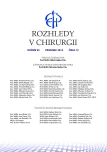-
Medical journals
- Career
Popliteal artery entrapment syndrome
Authors: I. Guňka 1; P. Janata 1; M. Leško 1; J. Raupach 2; A. Ferko 1
Authors‘ workplace: Chirurgická klinika, LF a FN Hradec Králové, přednosta: Prof. MUDr. A. Ferko, CSc. 1; Radiologická klinika, LF a FN Hradec Králové, přednosta: prof. MUDr. A. Krajina, CSc. 2
Published in: Rozhl. Chir., 2014, roč. 93, č. 12, s. 586-589.
Category: Case Report
Overview
Popliteal artery entrapment syndrome is a rare cause of lower limb ischaemia. It is caused by an abnormal relationship between popliteal artery and its surrounding musculotendineous structures (anatomic entrapment). Functional popliteal entrapment is characterized by normal anatomic relationships within popliteal fossa. The true incidence is unknown, it usually affects young patients, typically men, and is clinically presented with symptoms of calf claudication, calf cramping, coldness and paresthesia. CT angiography and MR angiography have become an imaging technique of choice. The mainstay surgical procedure is popliteal artery release. In cases of popliteal artery damage autologous saphenous vein bypass grafting offers the best long-term results. Authors on the basis of two case reports describe the clinical course, diagnosis and surgical technique used in the treatment of patients with advanced popliteal artery entrapmentsyndrome.
Key words:
lower limb ischaemia − entrapment syndrome − popliteal artery
Sources
1. Stuart TP. Note on a variation in the course of the popliteal artery. J Anat Physiol 1879;13 : 162.
2. Hamming JJ. Intermittent claudication at an early age, due to an anomalous course of the popliteal artery. Angiology 1959;10 : 369−71.
3. Bouhoutsos J, Daskalakis E. Muscular abnormalities affecting the popliteal vessels. Br J Surg 1981;68 : 501−6.
4. Gibson MH, Mills JG, Johnson GE, Downs AR. Popliteal entrapment syndrome. Ann Surg 1977;185 : 341−8.
5. Levien LJ, Veller MG. Popliteal artery entrapment syndrome: more common than previously recognized. J Vasc Surg 1999;30 : 587−98.
6. Stager A, Clement D. Popliteal artery entrapment syndrome. Sports Med 1999;28 : 61−70.
7. Erdoes LS, Devine JJ, Bernhard VM, Baker MR, Berman SS, et al. Popliteal vascular compression in a normal population. J Vasc Surg 1994;20 : 978−86.
8. Pillai J, Levien LJ, Haagensen M, Candy G, Cluver MD, Veller MG. Assessment of the medial head of the gastrocnemius muscle in functional compression of the popliteal artery. J Vasc Surg. 2008;48 : 1189−96.
9. Levien LJ. Popliteal artery entrapment syndrome. Semin Vasc Surg 2003; 16 : 223−31.
10. Marzo L, Cavallaro A, Mingoli A, Sapienza P, Tedesco M, et al. Popliteal artery entrapment syndrome: the role of early diagnosis and treatment. Surgery 1997;122 : 26−31.
11. Ozkan U, Oğuzkurt L, Tercan F, Pourbagher A. MRI and DSA findings in popliteal artery entrapment syndrome. Diagn Interv Radiol 2008;14 : 106−10.
12. Anil G, Tay KH, Howe TC, Tan BS. Dynamic computed tomography angiography: role in the evaluation of popliteal artery entrapment syndrome. Cardiovasc Intervent Radiol 2011;34 : 259−70.
13. Murray A, Halliday M, Croft RJ. Popliteal artery entrapment syndrome. Br J Surg 1991;78 : 1414−9.
14. Collins PS, McDonald PT, Lim RC. Popliteal artery entrapment: an evolving syndrome. J Vasc Surg 1989;10 : 484−9.
15. Kim SY, Min SK, Ahn S, Min SI, Ha J, et al. Long-term outcomes after revascularization for advanced popliteal artery entrapment syndrome with segmental arterial occlusion. J Vasc Surg 2012;55 : 90−7.
16. Steurer J, Hoffmann U, Schneider E, Largiader J, Bollinger A. A new therapeutic approach to popliteal artery entrapment syndrome (PAES). Eur J Vasc Endovasc Surg 1995;10 : 243−7.
Labels
Surgery Orthopaedics Trauma surgery
Article was published inPerspectives in Surgery

2014 Issue 12-
All articles in this issue
- Transanal total mesorectal excision for rectal cancer – just a fashion trend?
- Colorectal liver metastases surgery – the present and the perspectives
- Predicting pN positivity in T3 rectal cancer
- Risk factors for anastomotic leakage following rectal resection – Multicenter study
- Complicated mesenteric ischaemia
- Popliteal artery entrapment syndrome
- Perspectives in Surgery
- Journal archive
- Current issue
- Online only
- About the journal
Most read in this issue- Popliteal artery entrapment syndrome
- Complicated mesenteric ischaemia
- Transanal total mesorectal excision for rectal cancer – just a fashion trend?
- Predicting pN positivity in T3 rectal cancer
Login#ADS_BOTTOM_SCRIPTS#Forgotten passwordEnter the email address that you registered with. We will send you instructions on how to set a new password.
- Career

